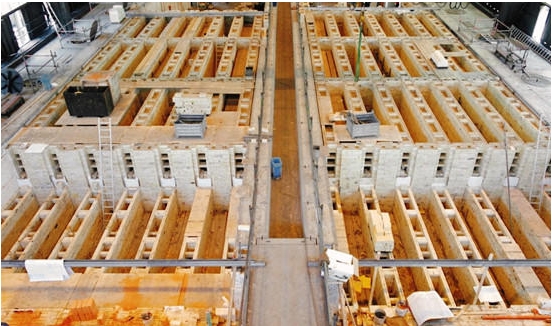- 27
- Nov
The lining scheme of the roaster connecting the fire channel, the overall construction process of the carbon furnace lining~
The lining scheme of the roaster connecting the fire channel, the overall construction process of the carbon furnace lining~

The construction plan for the lining of the anode baking furnace connected to the fire channel is assembled by the refractory brick manufacturer.
1. The lining construction of the connecting fire channel of the roasting furnace:
There are two masonry ways to connect the fire channel:
(1) One type is a three-layer lining structure, from the inside to the outside in the order of insulation board → insulation board → lightweight castable.
1) Check the construction quality of the steel smoke pipe and the metal support frame before the construction of the connecting fire.
2) The pipe lining should be pre-laid dry once and the joints should be inspected, and then the masonry should be started after passing the test.
3) Each ring of lock bricks should be wedged tightly, and the upper half ring of the pipeline lining needs to be supported with arch tires for masonry.
4) After the lining of the pipeline is completed, the jointing will be carried out, and the joint will be lined with thermal insulation fiber joint carpet felt.
5) Clean the construction area, and then apply protective paint.
(2) The other lining structure uses all castables. Generally, there are two construction methods: cast-in-place and spraying. The specific castable construction plan should be determined according to the design requirements.
2. Retention of expansion joints:
During the overall construction of the roasting furnace, expansion joints should be provided in all parts including the bottom plate, side walls, cross walls, end walls, connecting fire channels, and fire channel walls.
The location and size of the expansion joint should meet the design and construction requirements, and the template can be used to control and adjust, and the joint should be densely filled with refractory and thermal insulation materials. Note: During the construction of the roasting furnace, the number of densely filled aluminum silicate fiber blankets in the seam is generally more than that of the original design, so the order quantity of filling materials should be increased appropriately.
3. Processing of refractory bricks:
(1) Refractory bricks must be machined. Before construction, the required number and specifications of refractory bricks must be processed according to the design requirements.
(2) After the designed refractory bricks are processed, they are numbered and stored in an orderly manner until they enter the site for masonry.
(3) The bricks to be processed due to masonry tolerances during construction should be accurately processed by the constructors according to the required specifications and dimensions.
4. Cleaning of the roasting furnace: After the refractory lining of each part of the roasting furnace is completed, use an air compressor with other cleaning tools to clean the construction area.
5. Scaffolding support:
1 Double-row scaffolding for side wall masonry and double-row scaffolding for horizontal wall masonry;
The masonry of the fire channel wall adopts metal frame stools, each furnace room is placed according to 4 bins, the metal frame stool has two erection heights 1.50m and 2.5m, the width is according to the design size of the bin, and the distance between each side and the bin It is 50mm.
When the lining of the roasting furnace is built to 15 floors, the 1.5m elevated stool is hoisted into the material box using a crane for masonry. On the 28th floor, the 1.50m elevated stool was taken out and hoisted into the 2.50m elevated stool for masonry. When it reaches the 40th floor, put the 1.5m stool on top of the 2.50m elevated stool for masonry.
6. Transport of refractory materials:
(1) Refractory brick transportation: When refractory bricks of various materials of the roasting furnace are taken out of the brick warehouse for masonry, they are transported horizontally by vehicles and forklifts are used for loading and unloading. For vertical transportation, the fortification crane installed in the factory building should be used.
(2) After the refractory bricks are transported to the roasting furnace construction site, they are unpacked (light-weight thermal insulation bricks may not be disassembled) and placed in the hanging boxes with marked numbers, and then lifted to the platforms on both sides and the middle of each furnace chamber by crane , And then transported to each masonry frame manually.
(3) Transportation of refractory mud: pour the prepared refractory mud from the mixer into the steel ash basin, hoist it to the platforms on both sides of the furnace in the workshop, and then manually transport it to the masonry area.
